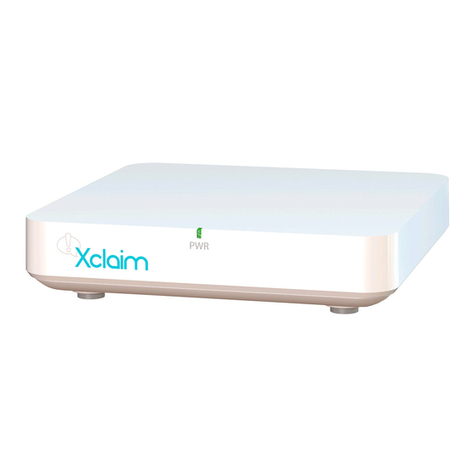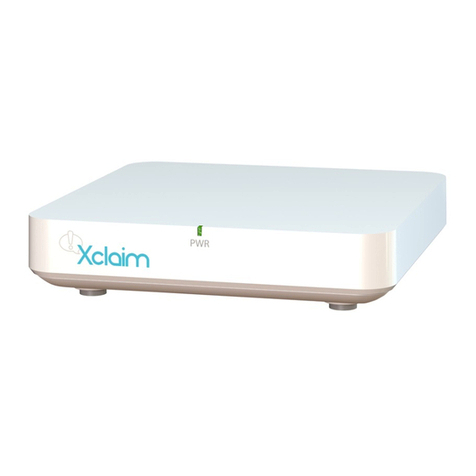Copyright © 2015 Ruckus Wireless,
Inc.
Published May 2015
Step 2b: Attaching the Mounting Bracket to a Metal
Pole
The AP mounting bracket attaches to the AP using a captive
screw. Loosen the screw (A in Figure 6) and pull up on the end
of the bracket to remove the bracket from the AP (B in Figure
6).
Insert the open end of one steel clamp into two of the slots on
the mounting bracket.
NOTE: The mounting bracket can be mounted to a vertical or
horizontal pole to support the AP in the required orientation.
Using either of the two options shown in Figure 8, use the
clamp(s) to attach the mounting bracket to the pole. Tighten the
clamps to 3 N.m or 27 in-lbs, or per manufacturer’s
specifications if the factory-supplied clamps are not used.
If necessary, daisy-chain the other steel clamps to
accommodate larger poles.
Figure 8 – Mounting bracket on a pole
Continue with Step 3: Mounting the AP.
Step 3: Mounting the AP
Snap the AP back onto the mounting bracket (A in Figure 9),
and use a medium flat-blade or No. 2 Phillips screwdriver to
tighten the captive screw to 1.1 N.m or 10 in-lbs to secure the
bracket to the AP (B in Figure 9).
Figure 9 – Attaching the mounting bracket to the AP
Optional Step: If you also need to lock the mounting bracket to
the AP, then use a matching security screwdriver to screw the
customer-supplied locking stainless steel 6mm M3 panhead
security screw through the mounting bracket and into the AP
chassis.
CAUTION: Make sure that the customer-supplied locking
stainless steel M3 panhead security screw is no longer than
6mm. If the security screw is longer than 6mm, it can damage
the AP chassis.
Figure 10 – Locking the mounting bracket to the AP
Continue with Step 4: Earth Grounding the AP.
Step 4: Earth Grounding the AP
CAUTION: Make sure that earth grounding is available and
that it meets local and national electrical codes. For additional
lightning protection, use lightning rods and lightning arrestors.
NOTE: The color coding of ground wires varies by region.
Before completing this step, check your local wiring standards
for guidance.
Using the factory-supplied ground wire and ground screw,
connect a good earth ground to the AP chassis ground point (A
in Figure 12).
CAUTION: The Xo-1 AP includes one 12mm stainless steel
M6x1 earth ground screw with split lock and flat washers. Make
sure that any replacement screw is no longer than 12mm. If a
screw is longer than 12mm, it can damage the AP chassis.
Figure 11 – Connect good earth ground to the AP here
Optional Step 5: Mounting and Connecting an External
5GHz Antenna
You can optionally connect two customer-ordered 5GHz
external antennas to the standard N-type female connectors on
the Xo-1 AP.
Disconnect the AP from its power source.
WARNING: Before connecting the antennas to the AP, make
sure that you disconnect the AP from the power source.
NOTE: Refer to Required Hardware and Tools for information
on tested 5GHz external antennas.
Unscrew the metal caps that protect the antenna connectors.
Place the metal caps in a safe place for later use.
If the antennas come with RF coaxial cables (for example, a
patch antenna), then physically mount the antenna, preferably
on the same mounting structure as the AP.
NOTE: Mount the external antennas at least 20cm (7.9”) away
from each other and away from other antennas, if possible.
If the antennas do not use RF coaxial cables, then connect the
antennas directly to the antenna connectors on the AP. Use a
torque wrench to tighten the connectors to 1.58 N.m (14 in-lbs).
Follow all instructions provided by the antenna manufacturer.
--OR--
If the antennas do use RF coaxial cables, then connect the
antennas to the antenna connectors on the AP and on the
antennas. Use a torque wrench to tighten the connectors to
1.58 N.m (14 in-lbs). Follow all instructions provided by the
antenna manufacturer.
Apply weatherproofing tape to the antenna connectors as
described in the Ruckus Wireless N-Type Connector Sealing
Instructions.
Refer to the Xo-1 802.11ac Outdoor Access Point Installation
Guide and enable the 5GHz external antennas, and then set
the 5GHz external antenna gain.
CAUTION: If you are not connecting external antennas to the
AP, then make sure that the metal caps remain installed and
securely fastened to protect the interfaces from elements, such
as water and dirt.
Congratulations! You have mounted your Xo-1 access point.























